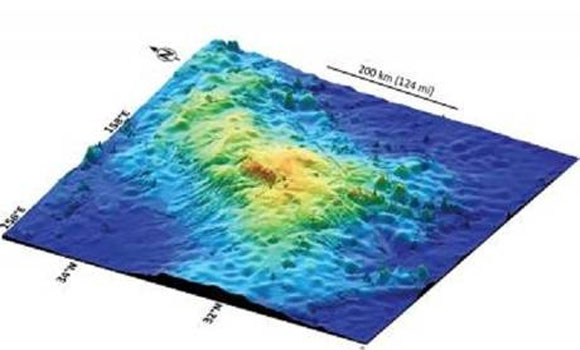Tamu Massif is as big as the British isles and was formed roughly 145 million years ago
The largest volcano on earth – and possibly the second largest in the entire solar system – has been discovered off the coast of Japan. With a footprint of roughly 120,000 square miles the “immense volcano” is roughly the same size as the British Isles.
The volcano, known as Tamu Massif, was originally thought to be three separate entities, discovered two decades ago by William Sager of the University of Houston.
“We got tired of referring to them as the one on the left, the one on the right and the big one,” said Sager. “We knew it was big, but we had no idea it was one large volcano.”
A paper submitted to the Nature Geoscience journal by Sager said: “We suggest that the Tamu Massif could be the largest single volcano on Earth and that it is comparable in size to the largest volcano in the Solar System, Olympus Mons on Mars.”
To put the size of the new discovery into scale, it is about 60 times larger than Earth’s most active volcano, Mauna Loa in Hawaii. However, most of the supercano’s size is horizontal, rather than vertical, and it has been called a “shield volcano” because of its low and broad shape.
“It’s not high, but very wide, so the flank slopes are very gradual,” said Sager to Nature World News. “In fact, if you were standing on its flank, you would have trouble telling which way is downhill.”
Sager describes the volcano’s shape as “different from any other sub-marine volcano found on Earth, and it’s very possible it can give us some clues about how massive volcanoes can form.”
“An immense amount of magma came from the center, and this magma had to have come from the Earth’s mantle. So this is important information for geologists trying to understand how the Earth’s interior works.”
As well as its size, Tamu Massif is also notable for its age – it’s approximately 145 million years old. Sager gave the volcano its unusual name in honour of the school he was teaching at the time – Texas A&M University (the ‘massif’ comes from the French for ‘massive’, a geologist’s term for a large mountain mass).
Fortunately, the volcano is in no way a threat, with its last eruptions probably happening a few million years after it was formed. “As much as we know that anything’s dead, this looks dead,” Sager told the Houston Chronicle.
Source: independent.co.uk


